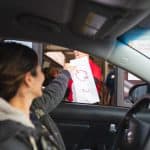Across the United States and beyond, communities are rallying around restaurants that have been impacted by the coronavirus.
For restaurants that are able, offering takeout service is the best (and often the only) means of pushing on despite the current situation. Every takeout order helps ensure our favorite restaurants are still around to welcome diners back into their establishments once this crisis is resolved. And it’s important that patrons recognize how much it helps — how much hope it provides — to restaurants when they place takeout orders.
What’s even more important is that restaurants offering takeout put the health of their customers and communities first.
Here are seven ways restaurants can keep customers safe:
1. Mitigate the risk of spread by offering only parking lot takeout.
For obvious reasons, you don’t want a flow of customers (and potentially viruses) in and out of your restaurants.
If offering takeout orders, in the interest of safety, you should set up a process by which your staff delivers food to customers waiting in their vehicles in the parking lot. Asking your customers to walk into your store to grab their food is unnecessary, potentially infective, and therefore risky.
With OneDine’s Parking Lot Order & Pay technology, customers can order on their mobile devices and notify the restaurant when they’ve arrived in the parking lot so food can be delivered to their vehicle. This feature is currently free as part of our #SaveOurRestaurants campaign.
Take notes from Canadian poutine truck Flying V Poutinerie, which is being extra cautious — while having a bit of fun, to boot — by delivering orders via extended hockey stick.
It doesn’t get more Canadian than poutine being served by a hockey stick 🍟😂- 📹 rebookajones #Canada #CoronavirusCanada #COVIDCanada pic.twitter.com/JJ85hblt4C
— Freshdaily (@freshdaily) April 6, 2020
2. Inform your customers as to the safety of eating takeout.
Fortunately for restaurants and their customers, the risks are low-to-none, according to the Food and Drug Administration.
Per the FDA, “there is no evidence to suggest that food produced in the United States can transmit COVID-19.” That’s good news for the restaurant industry. Don’t take us out of context, but our advice is this: spread it (the good news, of course). Offering peace of mind in the form of reputably sourced information is good for business and community awareness.
Of course, it’s important to be transparent and acknowledge that there’s no fail-safe method for preventing viral spread, and ordering takeout does entail a risk, albeit low. Restaurants should also let customers know the CDC recommends immediately throwing out all takeout packaging — paper/plastic bags, receipts, etc. — to mitigate the risk of spread.
However, it is fair to let customers know it’s generally safe to order takeout on social media posts, window banners, and other advertisements.
3. Prevent the spread by providing hygienic resources, staffing sparingly, and setting strict health protocols.
Food itself isn’t believed to be a likely source of deadly viral spread. But human contact is. More specifically, COVID-19 is primarily spread by coughing and sneezing.
So it’s important that restaurants operate at the absolute minimum personnel-wise, provide ample hygienic resources, and ensure proper health protocols to keep the risk of spread low. According to the University of Maryland School of Public Health, old reliable hand-washing remains one of the single-most effective preventative measures. Restaurants should preach its importance to their people.
Contact between staff members is the most dangerous aspect of continued operation. This considered, staffing sparingly is important, as is creating opportunities for restaurant staff to socially distance (six feet is the going rule of thumb). It’s also critical that restaurants provide staff with latex gloves, hand sanitizer, masks, etc.
4. Send staff members experiencing any COVID-19-related symptoms home.
There’s no such thing as being too careful in the face of a pandemic.
Restaurants should familiarize managers and other team members with COVID-19 symptoms. It should be abundantly clear that staff members exhibiting even mild symptoms are obligated to report them and immediately discontinue working. And many restaurants are going further by taking employees’ temperatures every day when they arrive for work.
5. Suspend use of third-party food delivery services.
As mentioned, human contact is the most common source of viral spread. And third-party food-delivery services only add one more human to the delivery chain. While third-party food delivery companies such as Postmates, Uber Eats, and DoorDash are doing everything they can to aid in the crisis, restaurants and customers alike should know that it’s best to avoid using them right now in the interest of minimizing food touchpoints.
6. Discourage or disallow cash payments.
Cash is one more potential source of spread. This considered, it’s wise to encourage customers to pay with a card — ideally over the phone — rather than hand over cash.
For restaurants accepting cash, it helps to ask customers to insert it in an envelope.
Contactless technology like OneDine’s PurePay™ payment options can make payment safer for everyone, employees and customers alike.
7. Limit contact with suppliers.
Again: Prevent human contact whenever and wherevxer possible.
If possible, sort out an arrangement with suppliers by which physical contact with staff isn’t necessary. Have suppliers drop off deliveries in a separate room, and request digital sign-offs. Suppliers should be willing to accommodate these requests given the situation.
Keeping customers and employees safe requires the ability to adapt quickly and stay flexible. Keeping these ideas in mind, and seeking out any and all others that can help you reduce contact, will be critical in weathering the COVID-19 storm.





